Binna Burra lodge, in the Gold Coast hinterland, rises from the ashes
Lush rainforest had always shielded historic Binna Burra lodge from bushfire – until last spring. What happened, and what can be salvaged?
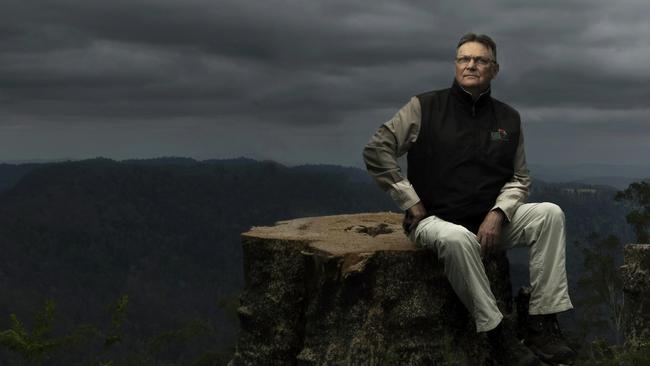
On a clear day atop Mount Roberts you can look over the emerald Illinbah Valley, past the glittering waters of Hinze Dam and smile gently, because there is no better place to be than right here at Binna Burra. Steve Noakes fell in love with this corner of tangled forest and plunging vistas on the lip of the Gold Coast hinterland when he was a boy on school camp. It’s a familiar story, one that echoed through generations of countless families before the historic tallowwood eco-tourism lodge was destroyed by bushfire last spring, the harbinger of Australia’s black summer.
Noakes, the boss of the business, was in Jakarta with his other job as an ecotourism developer when the news came through that Binna Burra was under threat. He couldn’t believe it. Fanned by 90km/h winds, the fire hadn’t pulled up at the World Heritage-listed rainforest like it was supposed to, like it always had. Instead, flames licked through or around the leafy stands of hoop pine and fig trees and burst into the dry eucalypt woodland below the escarpment.
By the time he caught the last flight out of the Indonesian capital on Friday, September 6 and made his bleary-eyed way up the mountain next morning, the situation was desperate. The air was thick with smoke. Glowing embers were falling from the sky like hissing meteors, blown kilometres ahead of the inferno. His wife, Suzanne, was at the fireground with the volunteer brigade from Beechmont, close to where they lived. She told him their home was likely to go. Thankfully, the 200-odd guests at the lodge and campsite had already been evacuated. No one had wanted to think about what could happen to them if the winding access road was cut, which it soon was. Water bombers made one run after another. But as evening fell, everyone was ordered to leave. Noakes grabbed something to eat, checked in with Suzanne and climbed into the back of a borrowed troop carrier to sleep, perversely rugged up in a thick jumper and socks against the chill of the night. There was nothing to do but to hope for a miracle. It didn’t come.
By dawn on September 8, the shingle-roofed lodge, known for its welcoming open fireplace and snug library, was a charred ruin, razed alongside the rustic cabins that were booked out months in advance in high season. The new Sky Lodge apartments were gutted. The last steeply inclined reach of the road had been made impassible by fallen trees and landslips. Groom’s Cottage, an adjoining tea house, a few safari tents and the barn were all that was left standing. When he eventually reached the blackened site, Noakes looked around and thought: My god, where do we start?
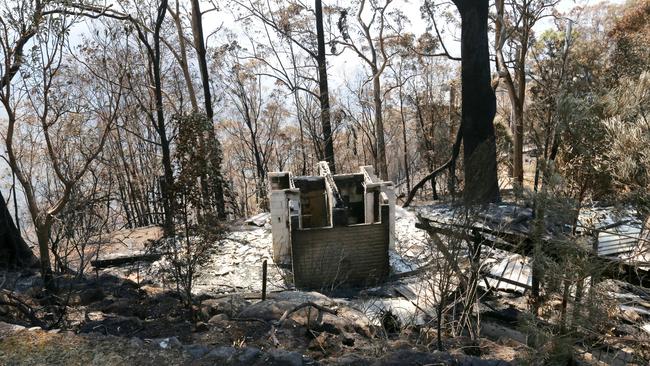
Thirteen months on and the sun is beating out of one of those big, blue Queensland skies that make your eyes water in the shade. Noakes, 64, is welcoming a group of sightseers back to Binna Burra, still very much a work in progress. “Glad you made it,” he says. The road, as it turned out, was in much worse shape than anyone could have imagined. Workmen had to don abseiling gear and dangle over a stomach-churning drop to repair the worst-affected sections. It reopened on September 4 this year. By then, most of the $3 million insurance payout had been spent, barely denting what was lost in the fire. True, the structural shell of the Sky Lodges had survived, allowing the accommodation units to be repaired in time for the spring school holidays. Not before time, Noakes says, because the business hadn’t earned a cent in more than a year. “We’ve had to borrow money from shareholders, the bank. So our debt is pretty high right now.” Another problem to manage.
He’s a bundle of energy in khaki trousers and fleecy vest. They might be baking on the distant Gold Coast beaches but here on the mountain grey tendrils of morning mist cling to the thickly forested landscape of Lamington National Park, slowly dissipating in the sunshine. Whatever the thermometer says on the coastal plain below, it’s at least 4C cooler in the ranges. The bush is green again, verdant with new growth. You wouldn’t know it had burnt so recently.
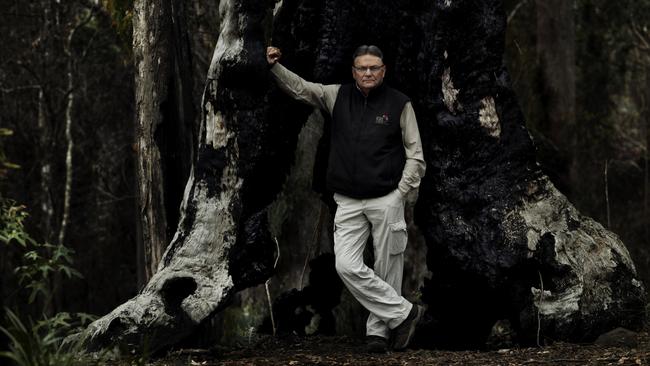
Standing outside the freshly painted tea house, in the last throes of being refurbished, he picks up the story of what happened after the fire went through the top side of the site. The water bombers flew non-stop to lay down a pink shield of frothy retardant. “That’s what they had to save,” he says, pointing to a telecommunications mast towering above the swaying trees. “If that had gone it was all over. They wouldn’t have been able to co-ordinate a thing.”
The surviving buildings were collateral beneficiaries, providing both the platform on which to rebuild and an opportunity to makeover the tired facilities. Corrugated metal roofing was erected over the safari tents and new bunk beds installed, accounting for another $500,000. Groom’s Cottage, the first structure completed when the compound was developed in the 1930s, received a new kitchen and bar, with the lost library reprised upstairs. But the biggest challenge remained: what to do about replacing the destroyed lodge, the heart and soul of the set-up?
Noakes admits he thought about walking away. “Worst-case scenario, and I looked at that after the fire, was that we mothball everything, just leave it all until we could work out how we were going to raise the money,” he says. But he couldn’t do that. No one involved with Binna Burra could. The place exerts a hold on everyone from staff to shareholders and the many, many thousands of people who have visited or stayed, returning year after year.
The initial damage went beyond bricks and mortar. Fifty-eight workers had lost their jobs but businesses across the Gold Coast region rallied: within a few weeks of the fire, 155 job offers had rolled in. Cameron Dick, a senior minister in the Queensland government, reached out. His family were regulars at Binna Burra and he wanted to help. A state government task force was set up with all the main players at the table – forestry, main roads, heritage, energy – and it met on the Wednesday after the fire to begin nutting out a recovery plan. “Without that we would be years behind,” says Noakes.
Scott Morrison helicoptered in and his first words were: “Where’s Steve?” They had worked together in the 1990s when the future PM was with the Tourism Council of Australia and Noakes headed the regional visitors’ and convention bureau in Cairns. Morrison told him to send the paperwork to his office to get federal assistance happening. But this was only the beginning of what would turn out to be one of the worst bushfire seasons on record, torching more than 18 million hectares from one end of the country to the other, destroying around 3000 homes and killing at least 34 people. The National Bushfire Recovery Agency that was set up to speed the rebuilding actually worked against them. “Our documentation was sitting on ScoMo’s desk when it got pushed over to the agency,” Noakes says. “It had almost got to the stage where he was going to give it the tick, hopefully in the yes box, and then the bureaucracy started.”
Eventually, $1.77m came through but by then the estimated damage bill was approaching $25m, and that didn’t take into account the roadwork (covered by the state). The lodge and cabins site wasn’t cleared until April and Noakes says replacement buildings are likely years away. “If the resources become available for us to do the lodge that’s lovely, but I’m not sweating over it,” he explains. “It can happen down the track. The priority for now is to get some money in and more of our people back to work. We can run a scaled down, more efficient business with what was left after the fire. We’re comfortable with that.”
He needs to be. The emotional buy-in means some very different people have deeply entrenched views on what should come next. In this respect, the operation is a captive of its unique history. While it was incorporated as an unlisted public company, the business actually functions like a co-operative, harking back to its establishment in the 1930s when Queensland’s national park estate was taking shape.
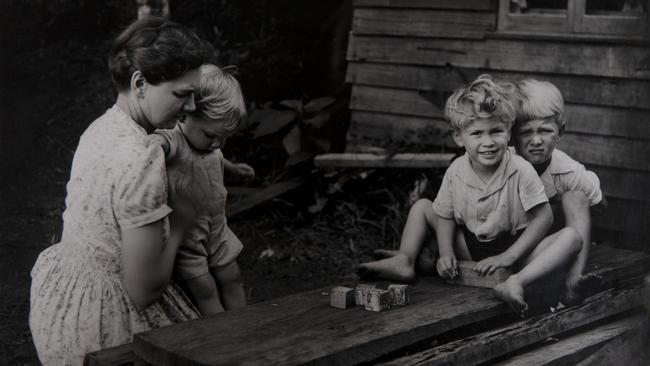
After experiencing the harrows of combat in World War I, Romeo Lahey found solace in the majestic forests. He and Brisbane journalist Arthur Groom, an avid bushwalker, made it their mission to introduce the public to the newly gazetted Lamington National Park. They formed the Queensland National Parks Association and Binna Burra was their first project, a place where anyone could come to camp. The lodge and original cabins followed when Queensland Holiday Resorts Pty Ltd was set up with 97 foundation shareholders.
Today, there are 650 of them, many with stakes that have been in the family for generations. No single investor can own more than 2 per cent and the biggest single holding, according to Noakes, is worth a notional $20,000. Notional because the shares are rarely traded: once obtained they tend to stay put, like the memory of a happy holiday.
The only time the company declared a dividend, it was handed back by the shareholders. No one is involved in Binna Burra for the money, says Tony Groom, the co-founder’s 81-year-old son. A black-and-white photo of him as a child with his siblings and their mother, Marjorie, is fixed to the wall of Groom’s Cottage, where he was raised. Life was basic, to say the least. Marjorie, the daughter of a Methodist minister, once encountered a tiger snake coiled in her underwear drawer. On another occasion a cow broke into the annexe that served as the parental bedroom and ate her best dresses.
Tony was 21 and working as a clerk when his late father’s second cousin, John Groom, suggested he take over the business. It was in a mess. The directors had wanted to cut their losses but the shareholders wouldn’t wear the idea of folding. While he sorted things out, his brother Donn was performing his own labour of love, building by hand a home set around an edifice of 10m rock walls. Tony bought it from his brother in 1975 and raised his family there. As Binna Burra burnt so did the magnificent house, 400m from the destroyed lodge.
The question of what comes next is a live one. Tony recently signed a contract to get the rebuild underway, but there’s no chance that Donn’s soaring rock walls, the heart of the old home, can be restored. Same goes for the lodge, assuming Noakes can come up with the funds to replace it. No one is suggesting it can be put back as it was. Noakes’ preference is for a chalet-style building on three levels. To make it fire-resistant, the structure would be concrete, clad in salvaged tallowwood and other local rainforest timbers. “Heritage is nice but heritage costs,” he says. He won’t look for an equity partner, as tempting as that is; the shareholders would rebel for sure. “We had a party come to us like that 15 years or so ago and it didn’t fly,” he says. “This is not a single-owner place … never was, never will be.”
The board of directors chaired by Noakes is also giving serious thought as to why the surrounding bush went up last year. The risk was well understood. The mountaintop site, thickly cloaked in greenery, had always been vulnerable to fire and was plausibly threatened in 1991, 1994 and 2002. But the belief was the rainforest would save it. When a winter control burn got away from volunteer firefighters a few months before that fateful September day, the flames were gently smothered by a jungly screen of subtropical vegetation.
Local school principal David Murphy, a stalwart of the Beechmont brigade, had never seen such severe fire conditions. It wasn’t just the hot, howling wind; the usually lush bush was so dry it crackled in the spring heat. Prolonged drought had reduced average annual rainfall from 1700mm to 1200mm in 2018 and barely 600mm by the time the fire hit.
The community is small enough for people to know who started it: a glowing cigarette butt flicked into the undergrowth was all it took. Queensland police later questioned two local youths but let them off with a warning. The first satellite detection of the blaze was on August 31 at Canungra, about 20km north of Binna Burra. The fire ripped through the dry eucalypt forest that crowds the slopes leading on to Binna Burra, dotted with deep pockets of rainforest. The question of exactly what burnt and when has fed the controversy over the retreat’s destruction.
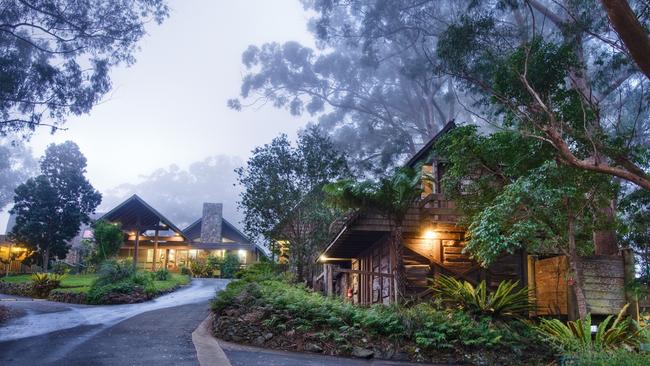
The local firefighters’ faith in the shielding quality of rainforest was not misplaced: Rod Fensham, a plant ecologist with the University of Queensland, says it is the Australian landscape’s antidote to bushfire, the “polar opposite” to eucalypt woodlands, which evolved to burn. The high and heavy rainforest canopy is the key, he says, creating a humid microclimate that is innately flame-resistant. Micro-organisms thrive on the shaded forest floor to speed the decomposition of tree litter and reduce fire fuel loads. “This environment is ecological magic,” Fensham says. “It can put fire out in Australia’s extreme fire climate.”
So what happened at Binna Burra? Fensham was camping at Mount Barney, about 50km to the west, that weekend and knew something was up. “The weather was just mad – a perfect storm for fire,” he recalls. But as the disastrous summer of 2019-20 progressed, with reports of rainforest stands ablaze across northern NSW, he resolved to get to the bottom of the mystery.
Weather and drought alone couldn’t explain the extent of habitat loss, even with the accelerant of climate change. When he reached the smouldering fireground around Binna Burra with researcher Patrick Norman from Griffith University’s School of Environment and Science, he found that for the most part the rainforest had survived. “The fire would hit the edge of the canopy and go to ground … trickle through the thin litter pretty consistently for 30m or 40m and then it would just go out,” he says. In all, about 500ha of true rainforest in the locale was lost, a fraction of the area burnt out.
Fensham realised he was missing something, a gate between the eucalypt forest and the “pure” rainforest which the fire had exploited. He started to look closely at the native brush box. This is a towering relative of the gum tree that grows on the rainforest fringe – and in just about any street you could name in leafy inner-Sydney or Melbourne. It has the thick, insulating bark of the eucalypt and needs flame to regenerate. Yet it shelters a thriving understorey of rainforest, effectively a fire inhibitor. “I had been thinking about this for ages,” Fensham says. “I just couldn’t imagine the conditions in which this type of forest would burn.”
Until September 8 last year, that is. Fingers of brush box-dominated “transition” forest created pathways for the fire to skirt the rainforest at Binna Burra, allowing the flames to roar up the eucalypt-clad eastern escarpment to the summit of Mount Roberts. And sure enough, when he checked the fire maps for other sites of purported rainforest loss, the pattern was similar. The transition forest absorbed the brunt of the fire’s fury, much as nature intended. “You can’t tell this story without noticing how by and large the rainforest wove its magic,” he says. “At Binna Burra, we saw this perfect correlation of the fire coming through the eucalypt forest, persisting through the brush box and going out at the edge of the pure rainforest. We did lose some rainforest … there were definitely places where it burnt,” he says. “Basically nothing is perfect when you are talking ecology.”
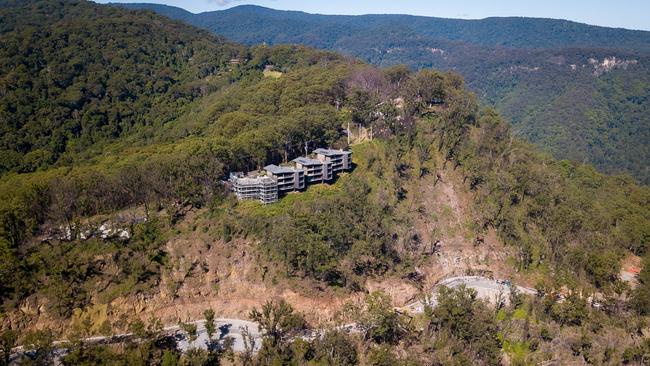
If Noakes’ plan stays on track he hopes to have another 20 people back on the payroll by the Christmas high season, taking the staff to 40. The campground is going again and each week brings another sign of life back to the business: the new bar at Groom’s Cottage boasts local beer on tap.
The next task is to develop Australia’s first via ferrata cliff climb off Bellbird Lookout, to bring in the adventure crowd. Volunteers have planted hundred of fire-resistant shrubs and trees around the base complex: the bush has dried out again and no one is complacent, not after last summer.
We’re talking by the stone fireplace where Tony Groom spent so many happy hours as a boy. He’s not the only one to have lost his home. Eight were destroyed in the street where Noakes and Suzanne raised their three children, all taught by David Murphy, of course. The oldest, Courtenay, 28, works as a teacher at the local school and gave birth to their first grandchild the week before the lodge burnt down. People put down deep roots here.
Suzanne helped save the home of another neighbour without knowing what had happened to their own much-loved property on that terrifying day. “We were incredibly lucky … the fire just seemed to go around it,” Noakes says. “Everybody was just devastated, I don’t know how else to describe it. And not everyone is rebuilding. Some people just couldn’t face it, and I can understand that. We have done it so tough as a community that it is nice to have a few things finally getting back to something like normal.”
He nods to the busy young staff members taking coffee orders at Groom’s Cottage; others are working at computers in the makeshift office adjoining the kitchen. Second-generation Binna Burra people, he says with quiet pride, the kids of kids who worked there. The place gets to you, all right. You only need to look out the window to see why.


To join the conversation, please log in. Don't have an account? Register
Join the conversation, you are commenting as Logout